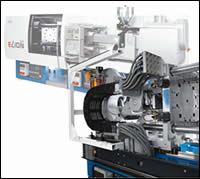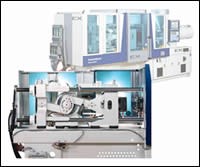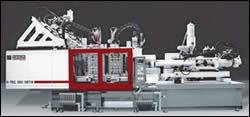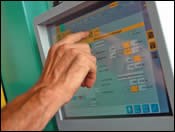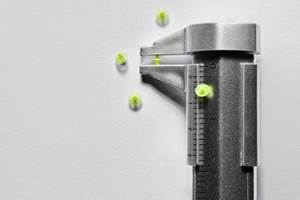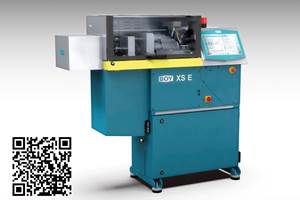K 2004 Wrap-Up on Injection Molding: Spotlight on Electric And Multi-Component Machines
Molders were treated to a trove of injection machinery introductions geared toward applications from micro-molding to packaging to large parts.
Molders were treated to a trove of injection machinery introductions geared toward applications from micro-molding to packaging to large parts. At least nine companies offered something new in electric machines. Several firms presented new developments in the equally hot area of multi-component molding. A number of space-saving two-platen presses were unveiled, as were new packaging machines designed to set new benchmarks for blazing speed. (News from the show in hot runners and robots will appear in later issues.)
New wave of electrics
In our September show preview, we reported on new electric and hybrid presses from Demag Plastics Group, Engel, MHI Injection Molding Machinery, Negri Bossi, Nissei, and Victor Taichung. A number of other new entries appeared at the show:
For example, Krauss-Maffei rolled out a new line of electric machines, dubbed the EX series, offered initially in a range from about 55 to 175 tons. The new series, which will ultimately replace the Eltec hybrid electric-hydraulic line, features a new modified toggle-clamp design called the Z-lever. It is said to be compact and to provide very precise movements. Water-cooled, high-torque servo motors are used for clamping and injection functions. The injection unit and controls are borrowed from the Eltec design. KM plans to roll out a 330-ton model later.
Netstal demonstrated all three models in its new all-electric Elion series. The all-servo system features a compact toggle clamp and a new injection unit. The three sizes are 55, 88, and 132 tons. The largest model molded ABS/PC cell-phone shells in two cavities in a 4-sec cycle. The company also plans to roll out a 200-tonner.
Milacron's Ferromatik Milacron Europe division premiered a new two-component electric machine in its Elektra Evolution series. This 2F model is currently the only Elektra Evolution unit that Milacron plans to offer in the U.S., primarily to European transplant manufacturers. (Milacron already offers Powerline and Fanuc Roboshot electric machines in the U.S.) The Elektra Evolution line (33 to 196 tons) has a new Mosaic touchscreen.
Arburg introduced two new sizes of Allrounder A electric toggle presses. The model 320 A comes in 55 and 66 tons. The company also showed Selogica Direct, a new touchscreen control as an alternative to the standard Selogica system with keyboard data entry.
The latest version of Battenfeld's electric EM series was developed in cooperation with Ferromatik Milacron. Elements of Milacron's electric machine technology (which both firms declined to specify) were incorporated into Battenfeld's EM line to raise its performance while also lowering its overall cost. The updated EM unit is said to be about 10% more precise and at least 20% more energy efficient than a standard hydraulic machine. The system still uses a five-point toggle clamp and Battenfeld's B4 controller. A new 33-ton EM model has been added at the bottom of the size range, which extends to 200 tons.
Sumitomo showed its new direct-drive (beltless, gearless) electric SED-HP line of 20 to 200 tons. The 200-tonner at the show (SE180D-HP) can inject at 800 mm/sec, suiting it to thin-wall applications.
MIR of Italy says its e-power line of all-electric toggle presses (154 to 440 tons) for thermoplastics, thermosets, and rubber will now be offered in the U.S. Mir also introduced a new electric add-on injection unit with 30 mm screw diam. and injection-pressure capability of 23,200 psi.
Sandretto unveiled its SMH 750 hybrid. The new clamp is a hydroblock design in which the tiebars are never exposed to the load of the platen and mold, thus eliminating deflection. Accumulator assist provides for quick lock-up. Automatic tiebar removal is standard on either top tiebar. The new drive system consists of fixed-displacement hydraulic gear pumps powered by AC servo motors. This approach is said to be highly efficient and to ensure faster, smoother operation. It will be available from 600 to 1100 tons, whereas Sandretto's standard SMH two-platen line starts at 1300 tons.
Fanuc of Japan presented a special Roboshot all-electric model called the S-2000i 100A, designed to inject at speeds up to 800 mm/sec. (It's marketed here by Milacron as part of the Roboshot Si-B series.) The system uses redesigned servo motors instead of more costly linear servos, which some other Roboshot models use for super-fast injection.
Multi-component's moment
One of the hottest topics in injection is multi-component molding, and the show offered several examples, including thermoplastic/thermoset combinations made in the same machine. Engel demonstrated the new Combimelt rotary-table system for its tiebarless Victory line, producing a strainer element in 35 sec in a four-cavity mold from glass-filled nylon and liquid silicone rubber (LSR). The offset vertical rotary table has three stations, of which the third station can be used for either additional cooling or part assembly.
Arburg also showed a molding cell to produce a part from nylon plus LSR on a 220-ton Allrounder 570 C in an "L" configuration.
Krauss-Maffei demonstrated what is said to be the first system to overmold a thermoplastic with a thermoset polyurethane skin. This SkinForm system uses a 176-ton KM 160-750 CX two-platen press to mold the nylon core of a car seatbelt cover. Then the mold shuttles to the side, where a PUR mixhead mounted on the moving platen machine injects a two-component, soft-feel covering material fed from a KM RIM-Star MiniDos PUR machine. After demolding by a robot, the part is placed in a punching unit, which cuts the PUR film gate. Total cycle time is 90 sec. Although the application is not yet commercial, the machine was purchased by automotive molder Sarnamotive Schenk GmbH in Esslingen, Germany.
A rotary stack-mold technology that assembles two parts in the mold and allows for in-mold adhesive labeling was developed by German moldmaker Foboha and demonstrated on a K-Tec 275-ton press from Ferromatik Milacron Europe. Foboha's new Twin Cube concept has two four-sided, rotating center stacks between the mold halves. Each center stack has 16 cavities per side, for 64 per cube. Each mold indexes 90° per cycle using its own drive mechanism and without sacrificing any of the opening stroke.
Two different-colored PP parts—the base and lid of a shallow spittoon for chewing tobacco—are molded with two injection units, one of them mounted on the moving platen at a 40° angle, which keeps the injection unit in contact with the valve bushing. After injection, each center stack turns to a cooling or label-inserting position, then turns again so the two parts face each other. When the press closes, the two parts are snap-fitted together and end up on one mold face. The parts were molded, assembled, and in-mold labeled in a 6.2-sec cycle.
Husky presented information on a new development that pulls together three of its process capabilities for high-volume, large-part, multi-material automotive applications. The proposed QTI system integrates Husky's Quadloc large-machine platform with its Tandem multi-tool stack technology and its Index system, a rotating center turret designed originally for PET preforms. The QTI system would have a rotating turret to transfer parts from one parting line to the other for overmolding. Material molded in the first cavity would stay on the core as the mold turns 180° on a horizontal axis to face the second molding cavity. Applications could include fascias, sunroof glazing, or instrument panels.
Milacron introduced a two-component all-electric press with hydraulic core-pull function. The Elektra Evolution EE 180 2F has a 180-ton clamp and 630 x 630 mm tiebar spacing.
Milacron demonstrated three-component molding on its 880-ton Maxima MM 800 Topline MSW 3F. It produced a fan shroud with a core of recycled PP, outer skin of virgin PP, and TPE sealing lip. The second injector was an Elektra Evolution add-on unit. The third component was plasticated and conveyed to the mold from an auxiliary extruder in the L position.
Engel demonstrated multi-component molding along with its Glazemelt injection-compression process, producing a car sunroof with integral frame. It used its Duo Combi press to produce a low-stress, clear PC window, which is coined in the mold and then a black PC frame is molded over it. (The first injection-compression molding of large PC car windows was shown by Battenfeld at NPE 2003.)
Demag Plastics Group now offers its Multi-plug universal add-on injector in more sizes and for both L (non-operator-side) and V (vertical) configurations.
Two-platens on parade
Demag showed off its new Titan line of two-platen machines with a 1220-ton model producing a spare-wheel protective cover made of long-glass reinforced PP. The cover was made using an injection/compression process. Fiber length was 11 mm going into the screw and 6 mm coming out the nozzle.
Krauss-Maffei showed two models in its new CX line of two-platen machines, which replace its 12-year old C series. The CX line has an electric screw drive for plastication (hydraulic drive optional). KM exhibited 38- and 88-ton models and plans to add units from 200 to 685 tons this year.
Milacron introduced smaller sizes in its Maxima two-platen line. New models range from about 300 to 880 tons, and three are wide-platen versions. Tonnage build-up time for the units is said to be about 0.5 sec and clamp speed is 1143 mm/sec.
Milacron teamed up with its D-M-E subsidiary to offer a new two-sided mold carrier that accepts two single-face molds as an option on the Maxima line.
Sandretto is rolling out a two-platen hybrid-electric design to replace its three-platen Micro Series. The new line, ranging from 30 to 80 tons, will come to the U.S. in the second half of 2005. Electric servo motors drive most rotary and linear functions, though clamp force is applied via a hydraulic pancake cylinder. The hydraulic system, which is encapsulated in the moving platen, also actuates core pulls. An update of Sandretto's Sef 2000 controller features a new 15-in. color LCD touchscreen.
(More new two-platen machines from Engel and Negri Bossi appeared in our September show preview.)
Preform power
Ultra-high output of PET preforms was demonstrated by Netstal with its new PET-Line 192 N system. The system is based on a PET-Line 660-ton machine and a brand new 192-cavity mold designed by Mold Hot Runner Technology (MHT) in Germany. The system can produce about 82,000 preforms/hr.
Netstal has a new continuous-plastication concept that reportedly helps to reduce acetaldehyde (AA) content in PET. According to Netstal, AA levels can rise when the screw pauses between injection cycles in a two-stage machine. Continuously turning the screw during the shooting phase of injection reportedly counteracts this effect.
Krauss-Maffei introduced a new PET preform system that uses a 187-ton press for the first time with a 48-cavity mold. The new Petform system incorporates a "Micro-pitch" tool design that packs more cavities into a limited space (down to 30-mm center distances). Micro-pitch is already used in Petform systems that mount a 96-cavity tool in a 330-ton press. The new system uses a KM 175-1900 CV machine with a vertical clamp, which delivers improved access for fast mold changes.
Husky has introduced a new HyFlo screw for its HyPET and Index lines of preform systems. The screw delivers around 15% higher output, plus better mixing and lower AA levels than previous designs, Husky says.
Productivity has also been hiked for multi-layer coinjection of barrier bottles. Kortec now offers a three-layer, 144-cavity system based on a Husky press, which runs on a 15-sec cycle.
While the major emphasis is on boosting preform output, some firms are also developing lower-cavitation systems. For example, Husky has designed a 90-ton HyPET machine capable of running eight cavities for prototype or low production runs. And Chen Hsong rolled out a "Chen PET" machine aimed at small to mid-size markets. It offers 24-, 42-, or 56-cavity systems. The largest of these utilizes a two-stage press. Chen Hsong holds the preforms in a water-cooling box through three cycles after demolding. Also on the small end, Boy Machines demonstrated molding up to 1100 preforms/hr on its 99-ton Boy 90A.
Higher speed in packaging
Fast new presses for thin-wall packaging from Engel, Netstal, and Milacron were reported in our September K preview. At the show, Krauss-Maffei revealed more information on its new Capable Advanced Packaging (CAP) system. It uses the new HPX double-flighted, high-output, low-temperature screw and a grooved barrel. A CAP unit based on the C3 Sprinter two-platen press has a modified clamp design for quicker tonnage build-up and release. It reportedly dry cycles in 2.1 sec, whereas 2.3 sec is said to be typical in the market. KM's own robot system pulled eight PP containers from a 600-ton CAP system in 0.6 sec (dry cycle was 0.3 sec).
Krauss-Maffei also showed its CAP concept in an all-electric, two-component version producing a thin-wall PP-EVOH-PP container.
Demag showed a new 615-ton EL-Exis hybrid machine developed specifically to meet U.S. demand for higher cavitation in stack-mold packaging applications. A 770-tonner is in the works.
Demag also demonstrated in-mold labeling (IML) in a two-cavity family mold for a container and lid on a 165-ton EL-Exis S. The tool, from Swiss moldmaker Glaroform had an IML system from Beck Automation of Switzerland. It decorated the side and bottom of the container and the top of the lid. Demag says this application requires precise injection speed, pressure, and volume to fill the mold without moving or degrading the labels.
Husky partnered with automation provider Hekuma to offer a compact IML system. Husky integrated its Hylectric model with Hekuma's robot to mold two 300-cc drinking cups in a 3.4-sec cycle. (Others running IML systems at the show included Arburg, Boy, and Toshiba.)
Micro-machines multiply
Arburg has broadened its Allrounder U line of small hydraulic presses with two new clamp sizes of 27 and 44 tons in addition to the existing 38.5-tonner.
DEU Injection Systems of Spain, which is looking for a U.S. representative, introduced its smallest hydraulic presses—27 and 55 tons. DEU builds presses up to 2750 tons.
Milacron has a new electric model for micro-molding. The Elektra Evolution 30 (33 tons) has a 14-mm-diam. screw. It produced a medical filter with a shot weight of 1.2 g at the show.
Demag demonstrated micro-molding on its 55-ton, all-electric IntElect 50 machine. A 0.0037-g acetal ink-metering device for a ballpoint pen tip was molded in a 32-cavity hot-runner mold built by Stamm AG of Hallau, Switzerland. The parts were removed, along with the cold manifold sprues, and placed in oriented groups by side-entry handling equipment.
(Other micro-molding exhibits from Battenfeld and Boy were covered in our September show preview.)
Advances in large presses
Husky upgraded the capabilities of its Tandem molding system, which allows for the simultaneous operation of two standard, single-face molds in one machine while requiring less tonnage, like a stack-mold system. The new system has a new Harmonic Bar, which controls the opening and closing strokes of both mold faces and allows use of two molds with dissimilar opening strokes and shut heights. The hot-runner system is now integrated into the center carrier, eliminating the bolt-on hot-runner plate to free up more daylight. The center carrier that supports the hot-runner system is now supported by low-friction roller bearings for higher clamp speed while using less power. And all services are centralized at the top of the center carrier for faster mold changes.
The QT1350 system at the show was designed to produce PP left and right car door panels weighing 910 g for the Renault Megane vehicle in a cycle time of 45 sec per part. The unit requires 50% less space than two separate machines.
Another novelty was Wilmington's new Lumina 1600h, which applies its structural-foam technology to multi-nozzle gas-assist injection molding. The 355-ton machine has a 25-lb shot and can shoot from single or dual accumulators into as many as 64 nozzle locations.
More new equipment
Engel expanded its Victory line of tiebarless hydraulic machines, adding 200-, 220-, and 240-ton models to the previous range of 65 to 165 tons. A 330-ton model is coming this spring. The company also announced that optional software is available to allow Victory Electric tiebarless presses to run its X-Melt process. These are hybrids with electric injection and hybrid clamp. X-Melt is usually run on Engel's all-electric E-Motion tiebarless line.
Demag Plastics Group has reorganized its product lines into three categories. Its Smart Line encompasses its standard machines, which include its Extra model sold worldwide, HT models produced in North America for the local market, Dragon models made in China for that market, and the Santosh series built in India for India, Africa, Asia, and Australia. Demag's Performance Line includes all its modular machines—the new Titan two-platen line, Caliber and Maxx two-platen designs, the Concept System, and all-electric IntElect. The Performance Line comprises machines for specialty or high-performance applications—EL-Exis S, Multi, Vertical, Praxis, and Newbury lines.
Demag also unveiled its new PC-based NC5 controller, which features larger data-storage capacity than the older NC4, plus a touchscreen monitor and USB interfaces. The controller will be available initially as an option for its Extra line, starting in the second quarter.
Related Content
Slimmer All-Electric Press Debuts
NPE2024: A slimmed-down version of Engel’s all-electric, e-mac injection molding machine is among eight displays, which also include LSR micromolding, quick mold changes and a cube mold.
Read MoreNew Machine Range Features Adjustable Clamp for Micromolding
The Boy XS E, successor to the XS series, features servodriven pump drives and different clamp configurations, as well as a special mold holder for optional micromolding operation.
Read MoreServo-Hydraulic Injection Molding Machine With an Electric Injection Unit Premieres
Fakuma 2024: Wittmann Battenfeld says the 2K SmartPower Combimould features a new electric injection unit option.
Read MoreMilacron’s Massive Booth Highlights Multiple Brands
NPE2024: Coinjection of postconsumer resin, in-mold decoration, LSR micromolding and bioplastics processing are just some of the machine displays at Milacron's booth.
Read MoreRead Next
People 4.0 – How to Get Buy-In from Your Staff for Industry 4.0 Systems
Implementing a production monitoring system as the foundation of a ‘smart factory’ is about integrating people with new technology as much as it is about integrating machines and computers. Here are tips from a company that has gone through the process.
Read MoreSee Recyclers Close the Loop on Trade Show Production Scrap at NPE2024
A collaboration between show organizer PLASTICS, recycler CPR and size reduction experts WEIMA and Conair recovered and recycled all production scrap at NPE2024.
Read MoreLead the Conversation, Change the Conversation
Coverage of single-use plastics can be both misleading and demoralizing. Here are 10 tips for changing the perception of the plastics industry at your company and in your community.
Read More



